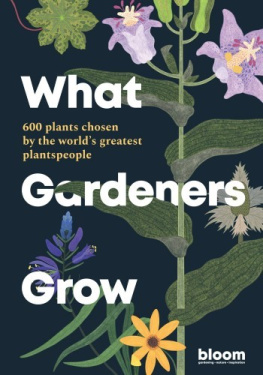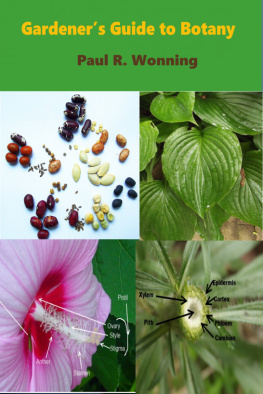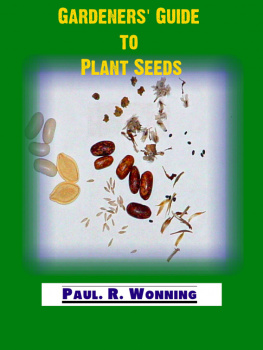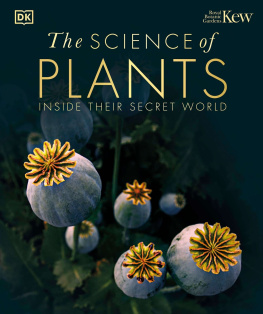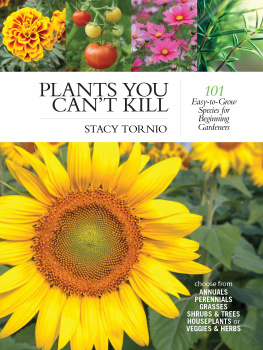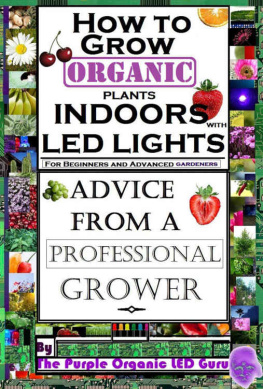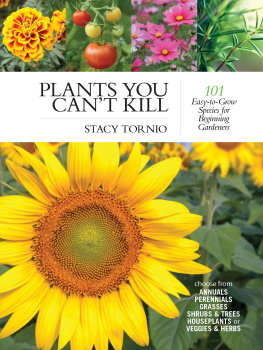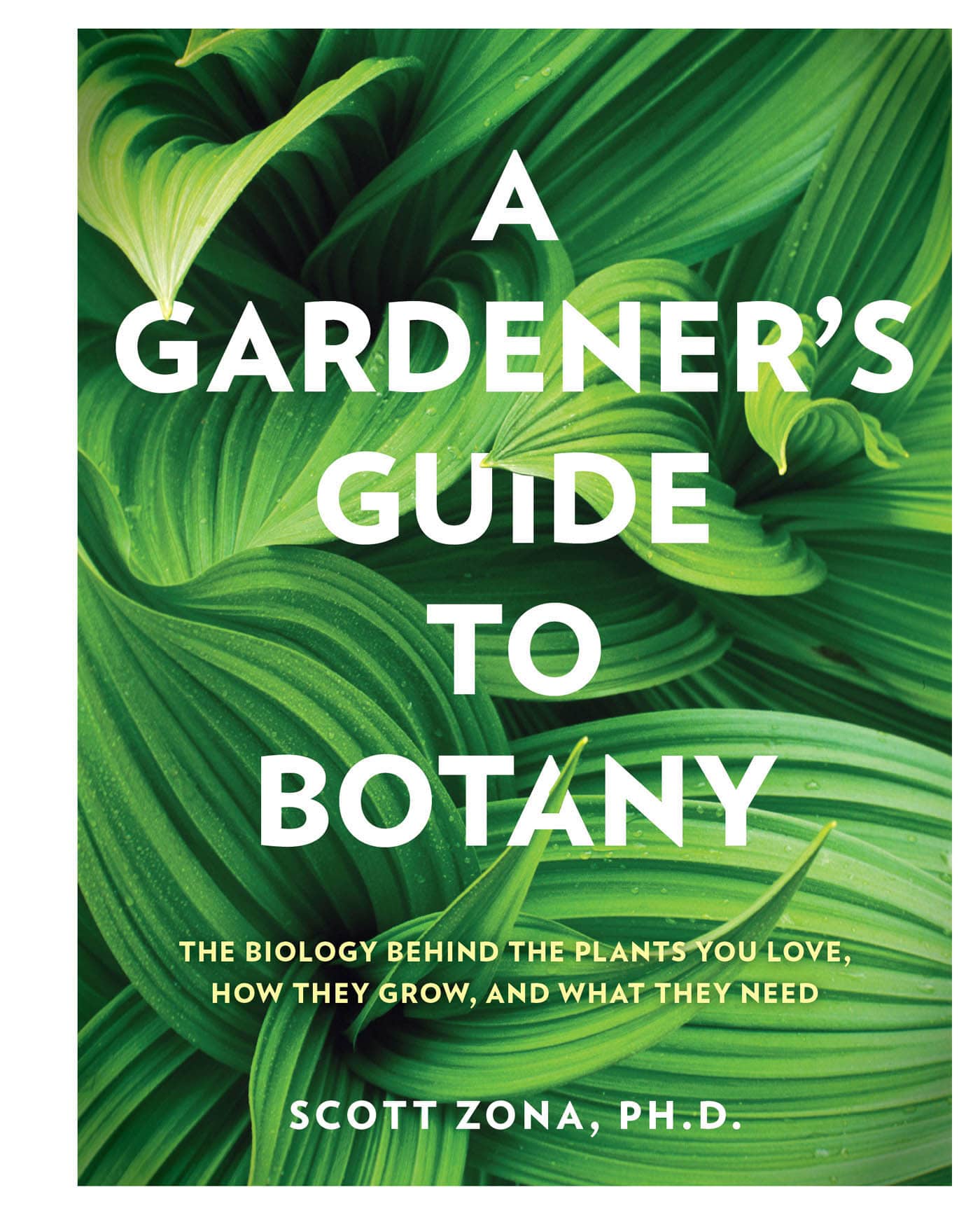Contents
Page List
Guide
Cover
A GARDENERS GUIDE TO BOTANY
THE BIOLOGY BEHIND THE PLANTS YOU LOVE, HOW THEY GROW, AND WHAT THEY NEED
SCOTT ZONA, PH.D.
PREFACE
As I sit down to write, I gaze at the windowsill near my desk. On it sits a dwarf sansevieria forming little rosettes of deep green leaves. Above it hangs a slab of cork on which is mounted a tiny air plant that is pushing out oversized, violet flowers, one at a time. Nearby are two plants, an agave and an aloe, that have similar forms, but one evolved in Mexico and the other in South Africa, respectively. Above them is a furry-leaved peperomia and a hybrid philodendron, both growing contentedly in the diffuse light that reaches the shelf next to the window.
Looking through the window to the back garden and the woods beyond, I am drawn into a tapestry of varied textures, colors, and forms. I see evergreen pines, deciduous oaks, azaleas from eastern North America and eastern Asia, herbaceous perennials that go to ground at the first hint of frost, and inevitably, weeds, both native and exotic. I see flowers of various shapes and colors, among which buzz ponderous bumblebees, aerialist hoverflies, and other insects too small and too fast to identify from my office window. The resident hummingbird zips into frame, feeding impatiently among the salvias, as a butterfly flits languidly overhead.
Some visitors to my office might not even notice the plants on the windowsill or in the garden beyond, or if they see them at all, they simply register them as green dcor, differing only in texture from the framed print on the wall or the ceramic vase on the shelf. More discerning visitors might see these plants as attractive, even interesting. They may even know the names of these plants, at least their common names. Yes, they are beautiful, living things, but to me, these plants are so much more. When I look at them, I see an intricate balance of light, water, and nutrients, chemical reactions responding to environmental cues and variables. The plants and their interactions with their environment and with one another tell a story, a story of competition and victory, of deception and commerce, of sex and survival. There are enough stories to fill dozens of books.
My most curious visitors might ask a question about a plant or two. When that happens, I can barely contain my delight. There is so much to tell.
CONTENTS
1
BEING A PLANT
FOR MOST PEOPLE, THE PLANT KINGDOM IS A FOREIGN LAND. Its inscrutable inhabitants are all around us, but they communicate in a language that seems unintelligible and untranslatable. Their social interactions are different, their currency doesnt fit in our wallet, and their cuisine... well, its nothing like what we eat at home. In the Plant Kingdom, we are just tourists. Without a guide, we can only gawk at their colorful costumes and unfamiliar customs.
Whether youre a seasoned traveler or a first-time visitor to the Plant Kingdom, this book is your guide to how plants live, how they are put together, and how they work. Its about how plants grow, not how to grow plants. It will guide you to all the usual tourist spots, but it will also take you to some out-of-the-way corners of the kingdom. And the best part is that there will be no long-haul flights, no unfamiliar bathroom fixtures, and no visa required. You can exit and reenter the Plant Kingdom as often as you like. A stroll in the garden or a hike through the woods is all it takes to begin a journey into a leafy, green world. This book will be your passport, your interpreter, your currency converter, and your host on a learning adventure into the world of plants. Before we go, we need to remind ourselves of what it means to be a subject of the Plant Kingdom.
Gunnera manicata unfurling its magnificent leaves to intercept the maximum amount of sunlight.
BEING A PLANT
Plants do things a bit differently from members of our kingdom, the Animal Kingdom. For one thing, most plants are autotrophs, meaning they can sustain themselves by manufacturing their own food. They do so by capturing water and carbon dioxide and using solar energy to form carbohydrates (sugars) in a process called photosynthesis. In contrast, most animals are heterotrophs, meaning they must acquire energy by eating other organisms. Very few plants stray into the realm of heterotrophs, as we shall see.
Monotropa uniflora lacks chlorophyll and is a heterotroph, an organism that must get its energy from other organisms. In the case of Monotropa, it gets its energy from fungi, which in turn get energy from photosynthetic plants.
Another distinctive aspect of the plant world is that plants are literally rooted to one spot. The underground half of the plant, the root system, is responsible for the uptake of water and nutrients. As the plant grows, it builds one or more stems that may be soft or woody. Strong, woody stems allow the plant to achieve great size and height, but climbers can obtain the same height without investing in self-supporting, woody stems. Larger stems require larger root systems, which take on the roles of supporting and anchoring the plant, in addition to absorbing water and nutrients.
The persistence of stems is related to the duration of the life cycle of plants. Gardeners know that plants may live for one year, two years, or many years. Annuals complete their life cycles in one year or less and have soft (or at most, slightly woody) stems. Biennials have a two-year life cycle, producing only vegetative growth in year one and then flowering and dying in year two. Perennials are long-lived plants (but not immortal). Herbaceous perennials have soft, nonwoody, aboveground growth that may die back during dormancy. Woody perennials have strong stems and may be climbers (vines), shrubs, or trees.
Its Not Official
Its worth mentioning that there is no botanical definition of a tree or shrub. We typically think of trees as large plants with a single, woody trunk. Shrubs can be large (but not as large as trees) and have one or more main stems. There is considerable overlap in these loose categories, and the question of what to call palms, bamboos, and Joshua trees (


